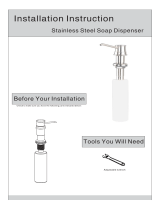
299H Series
17
24 Machine Screw, Steel (2 required) 1B420428982
25 Lever Pin, Stainless steel (2 required) 1H972935032
26 Lever, Steel T13813T0012
27 Vent Hood (Type Y602-12 Vent Assembly) 27A5516X012
28 Diaphragm Assembly, Nitrile (NBR) diaphragm
and steel diaphragm head T14259T0012
29 Closing Cap, Plastic 24B1301X012
30 Machine Screw, Steel (8 required) T14069T0012
31 Spring Case, Aluminum T14097T0012
32 Control Spring See Table 2
33 Spring Seat, Steel T13917T0012
34 Bonnet, Steel T14135T0012
35 Locknut, Steel 1A352224122
36 Adjusting Screw, Steel T14133T0012
37 Hex Nut, Steel 1E985324142
38 Washer, Steel 1F230328992
39 Diaphragm Post, Stainless steel
Types 299H and 299HS T13915T0012
Types 299HR and 299HSR T14033T0012
40 Pusher Post, Steel T13914T0012
41 Overtravel Spring, Stainless steel
Types 299H and 299HS T14136T0012
Types 299HR and 299HSR T14031T0012
42 Machine Screw, Steel 1A954828992
43 Rivet, Flat head, Stainless steel T13916T0012
44 Retaining Ring, Steel 16A6977X012
45 Check Valve Assembly T14258T0012
46 Machine Screw, Steel (4 required) T13920T0012
47 Inlet Fitting, Aluminum T13824T0012
48 Stem Assembly, Aluminum 1H9666T0012
49* O-ring, Nitrile (NBR) T13939T0012
50 Pilot Orice, Aluminum T13825T0012
51 Inlet Screen, Stainless steel T13791T0012
52* Pilot Disk Assembly, Hydrogenated Nitrile (NBR)
and Aluminum disk holder T13955T0012
53* O-ring, Nitrile (NBR) 1D682506992
54* O-ring, Nitrile (NBR) 13A2331X022
56 Screw, Steel (External Registration - 2 required
or Dual Registration - 1 required) 1E175828982
57 Lever, Steel T14134T0012
58 Pipe Plug, Steel 1A7715T0012
59 Pipe Plug, Internal Registration only, Steel
3/4 NPT 1A7715T0012
1/4 NPT 1A767524662
61 O-ring, Nitrile (NBR) (External Registration - 2 required
or Dual Registration - 1 required) 17A0960X012
62 Drive Screw, Steel (2 required) 1E501728982
63 Nameplate, Aluminum - - - - - - - - - - -
68* Wire Seal T14088T0012
69 Warning Tag, Aluminum - - - - - - - - - - -
70 Bleed Restriction, Steel
0.044 inch / 1.1 mm, Red (standard) 17A2029X012
0.071 inch / 1.8 mm, Green 17A2030X012
0.082 inch / 2.1 mm, Blue 17A7277X012
72 Filter Assembly, See P590 Series
Type P593-1 AJ5004T0012
Type P594-1 AJ5004000A2
78 Pilot Supply Tubing, Long (for constructions with
lter or pilot supply option) - - - - - - - - - - -
79 Pilot Supply Tubing, Short (for constructions with
lter or pilot supply option) - - - - - - - - - - -
80 Pad, Nitrile (NBR) T13830T0012
81 Diaphragm Head, Steel (2 required) T13812T0012
82 Insert (for Types 299HS and 299HSR only,
see Figure 7) Aluminum
(2)
T14013T0012
83 O-ring (for Types 299HS and 299HSR only,
see Figure 7) Nitrile (NBR)
(2)
T1072606562
84 Plate (for Types 299H and 299HR only), Steel
(2)
T14039T0012
85 O-ring (for Types 299H and 299HR only),
Nitrile (NBR)
(2)
T13769T0012
86 O-ring (for Types 299H and 299HR only),
Nitrile (NBR)
(2)
T13772T0012
87 Set Screw (for Types 299H and 299HR only)
(4 required)
(2)
1C629828992
88 Spring Seat, Types 299HR and 299HSR T14030T0012
89 Label, (not shown)
Types 299H and 299HS T1215806032
Types 299HR and 299HSR T1215906032
92 Tee, Stainless steel - - - - - - - - - - -
93 Spring Seat Washer, Delrin
®
19B0553X012
94 Plastic Plugs (not shown) T13543T0042
Optional P590 Series Filter
(Key 72, Figure 3)
Key Description Part Number
1 Filter Body
Type P594-1, Brass 1E312414012
Type P593-1, Aluminum 1E3125X0022
2* Filter Element, Cellulose 1E312606992
3 Filter Head
Type P594-1, Brass 1E312514012
Type P593-1, Aluminum 1E3125X0022
4 Machine Screw
Type P594-1, Brass 1J500218992
Type P593-1, Aluminum 1J500209012
5 Washer (2 required)
Type P594-1, Brass 1J500018992
Type P593-1, Aluminum 1J500010062
6 Spring Washer, Plated carbon steel 1H885128982
7* Gasket, Composition 1F826804022
Type VSX-2 Slam-Shut Device (Figure 7)
Key Description Part Number
1 Type VSX-2 Module FA196247X12
2* Upper O-ring, Nitrile (NBR) T13769T0012
3* Lower O-ring, Nitrile (NBR) T13772T0012
4 Set Screw (4 required), Stainless steel 1C629828992
6 Type Y602-12 Vent Assembly 27A5516X012
7 High pressure Control Spring, Zinc-plated steel
12 to 25 inches w.c. / 30 to 62 mbar, Black T14162T0012
20 to 52 inches w.c. / 50 to 129 mbar, Brown T14163T0012
1.4 to 3.9 psig / 97 to 269 mbar, Red T14164T0012
3.8 to 8.7 psig / 262 to 600 mbar, Orange T14165T0012
5.8 to 16 psig / 400 to 1103 mbar, Pink T14166T0012
11.6 to 23 psig / 800 to 1586 mbar, Green T14167T0012
8 Low pressure Control Spring, Zinc-plated steel
2 to 12 inches w.c. / 5 to 30 mbar, White T14168T0012
4 to 30 inches w.c. / 10 to 75 mbar, Blue T14169T0012
0.36 to 2.3 psig / 25 to 159 mbar, Unpainted T14170T0012
1.5 to 10.8 psig / 103 to 745 mbar, Olive T14171T0012
10 Machine Screw (for external control line), Steel 1H8162X0012
11* Gasket (for external control line), Nitrile (NBR) T14191T0012
12 Adjustment Tool (see Figure 8) FA142932X12
13 Pipe Plug (for internal registration),
Steel, (not shown) 1A767524662
* Recommended spare part
1. Cast iron or steel bodies without lter and pilot supply regulator require 1 connector; all other combinations of lter and/or pilot supply regulator require 3 connectors. Ductile iron
bodies without lter and pilot supply regulator require 2 connectors; all other combinations of lter and/or pilot supply regulator require 4 connectors.
2. Ductile iron bodies only.
Delrin
®
is a mark owned by E.I. du Pont de Nemours and Co.
Key Description Part Number
Key Description Part Number
Parts List (continued)
299H Series Regulator (Figures 4, 5
and 6) (continued)























